Volvo D7, D12 Service Manual
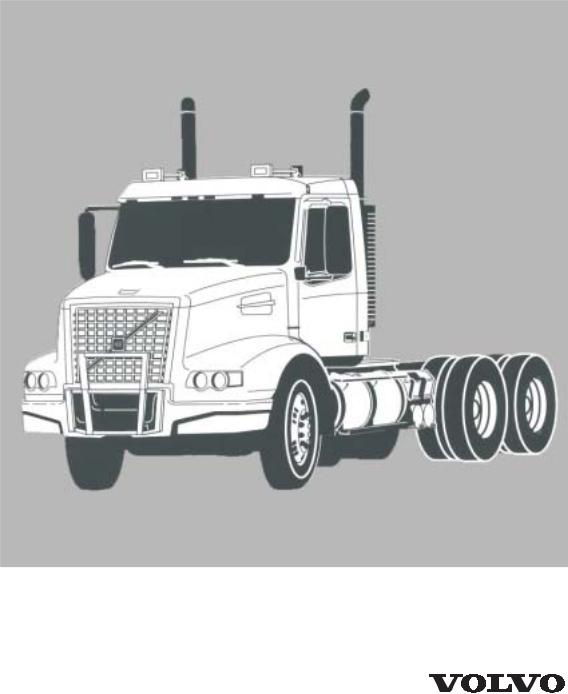
Operator's Manual
Maintenance and Engine
VHD
Foreword
This manual contains information concerning the safe operation of your vehicle. It is extremely important that this information is read and understood before the vehicle is operated. This manual also contains a considerable amount of information concerning the vehicle, such as vehicle identification, Preventive Maintenance recommendations and a log for your service records. Please keep this in the vehicle at all times. Information from other component manufacturers is supplied in separate manuals in the Owner’s Package.
NOTE! It is important that this manual stays with the vehicle when it is sold. Important safety information must be passed on to the new customer. The service information contained in this manual gives the owner important information about maintaining the vehicle but is not intended as a substitute for the Preventive Maintenance Service Manual and must not be regarded as such.
The National Highway Traffic Safety Administration (NHTSA) and Volvo Trucks North America, Inc. should be informed immediately if you believe that the vehicle has a defect that could cause a crash, injury or death.
Contact NHTSA by calling the Auto Safety Hotline at 1 (800) 424– 9393 (or 366–0123 in the Washington, DC area) or by writing to: NHTSA, U.S. Department of Transportation, Washington, DC 20590.
Volvo Trucks North America, Inc.
Greensboro, NC USA
Order number: PV776-TSP20 154789
© 2001 Volvo Trucks North America, Inc., Greensboro, NC USA
All rights reserved. No part of this publication may be reproduced, stored in retrieval system, or transmitted in any forms by any means, electronic, mechanical, photocopying, recording or otherwise, without the prior written permission of Volvo Trucks North America, Inc..

Contents
General Information ............................. |
1 |
Information For the Owner ................... |
1 |
Safety Information ................................. |
3 |
Proper Maintenance Procedure ............. |
3 |
Injury Prevention ................................... |
6 |
Engine Damage Prevention ................. |
15 |
Electric System Damage Prevention |
.. 17 |
Reporting Safety Defects .................... |
19 |
General Engine Design Information |
. 20 |
Engine Overview D7 ........................... |
20 |
Engine Overview, D12 ........................ |
22 |
Typical Engine Compartment |
|
Overview ............................................. |
24 |
Engine Features ................................... |
26 |
VECTRO II Parameter Values, D7 .... 27 |
|
VECTRO II Parameter Values, D12 |
.. 28 |
Engine Variants, D7 ............................ |
29 |
Engine Variants, D12 .......................... |
30 |
Engine Data ......................................... |
31 |
Engine Storage ..................................... |
32 |
Engine Storage .................................... |
32 |
Cooling System ..................................... |
34 |
General Coolant Information .............. |
34 |
Water Specification ............................. |
40 |
Additives .............................................. |
41 |
Antifreeze ............................................ |
42 |
Fuel System .......................................... |
50 |
Fuel Safety Reminders ........................ |
50 |
Diesel Fuel Specification .................... |
51 |
Fuel Additives ..................................... |
55 |
Alternative Fuels ................................. |
58 |
Oil System ............................................. |
59 |
Engine Oil ........................................... |
59 |
Oil Sampling ....................................... |
70 |
Severe Service Schedule for |
|
VHD-Series ........................................... |
74 |
General and Check-Chart ................... |
74 |
Maintenance Categories ...................... |
78 |
Heavy-Duty Service Schedule for |
|
VHD-Series ........................................... |
84 |
General and Check-Chart ................... |
84 |
Maintenance Categories ...................... |
89 |
Maintenance ......................................... |
95 |
Engine Maintenance ............................ |
95 |
Flushing Cooling System, D7 .......... |
121 |
Flushing Cooling System, D12 ........ |
124 |
Turbo and Charge Air Cooler ........... |
126 |
Replacing Fuel Filters ....................... |
128 |
Fuel System Service ......................... |
129 |
Transmission and Rear Axle Main- |
|
tenance ............................................... |
139 |
Steering and Brakes Maintenance .... 143 |
|
Electrical System Maintenance ......... |
149 |
Tires, Wheels and Hub Maintenance |
151 |
Chassis Maintenance ......................... |
155 |
Cab Maintenance ............................... |
157 |
Lubrication, VHD ............................. |
162 |
Viscosity and Capacity Tables .......... |
166 |
Literature ............................................ |
172 |
Service Assistance and Manuals ...... |
172 |
Service Charts .................................... |
174 |
Scheduled Services ........................... |
174 |
Repair Record ................................... |
177 |
Tire Record ........................................ |
183 |
Fuel and Oil Record ......................... |
194 |
Index .................................................... |
207 |
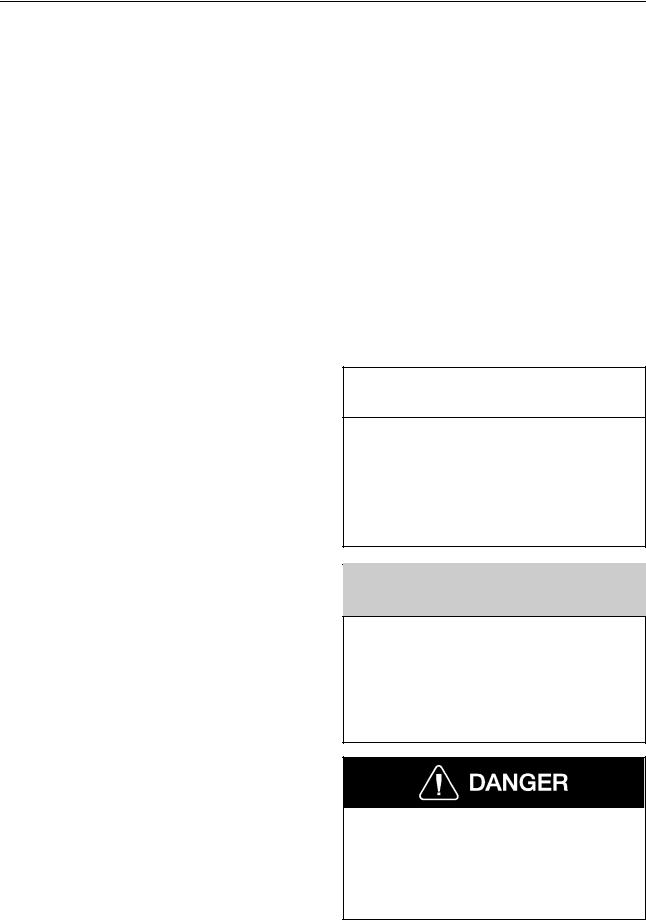
Warning Label Information
IMPORTANT
Before driving this vehicle, be certain that you have read and that you fully understand each and every step of the driving and handling information in this Operator’s Manual. Be certain that you fully understand and follow all safety warnings.
IT IS IMPORTANT THAT THE FOLLOWING INFORMATION CONCERNING LABELS IS READ, UNDERSTOOD AND ALWAYS FOLLOWED.
The following types of labels are used throughout this manual:
NOTE! A note defines an operating procedure, practice, condition, etc., which is essential to the proper operation of the vehicle.
 CAUTION
CAUTION
A caution label directs the operator’s attention to unsafe practices where personal injury is not likely but property damage could occur. The caution label is in black type on a white background with a black border.
 WARNING
WARNING
A warning label directs the operator’s attention to unsafe practices which could result in personal injury or severe damage to the vehicle. The warning label is in black type on a gray background with a black border.
A danger label directs the operator’s attention to unsafe practices which could result in serious personal injury or death. The caution label is in white type on a black background with a black border.

General Information 1
Information For the Owner
If there are questions on the maintenance and performance of your vehicle, please discuss them with your Volvo Truck dealer. Your authorized dealer is required to have trained mechanics, special tools and spare parts to fully service your vehicle. If necessary, your dealer will contact Volvo Trucks North America or other manufacturer for any assistance.
In addition to this Maintenance Manual, there may be additional instruction/operator’s manuals supplied by component manufacturers. These manuals are placed in the Owner’s Package and placed in the cab. Be sure to read all the manuals thoroughly before operating the vehicle.
Also, various safety labels may be placed on components by the component manufacturer. Be sure to read and follow these labels to prevent damage to the vehicle, personal injury or even death.
Information in this manual refers to Volvo components and Volvo drivetrain. Information concerning non-Volvo engines and/or drivetrains can be obtained by contacting the respective manufacturer.
Establish a Preventive Maintenance Program with the help of your local Volvo Truck dealer. A Preventive Maintenance Program makes it possible to maximize the amount of time your vehicle is up and running, resulting in longer component life. This makes for a safer vehicle by reducing any mechanical failures due to poor maintenance practices.
NOTE! Federal law requires manufacturers to notify owners of its products in the event of a Federal Motor Vehicle Safety Standard or if a safety related defect is discovered. If you are not the original owner of this vehicle, please notify us about the change in ownership at the address below or through an authorized Volvo Truck dealer. This is the only way we will be able to contact you if necessary.
Volvo Trucks North America, Inc.
P. O. Box 26115
Greensboro, NC 27402–6115
United States of America

2 General Information
Do Not Remove this manual from the vehicle. It contains important operational and safety information that is needed by all drivers and owners of this vehicle.
This Maintenance Manual covers all Volvo vehicles manufactured by Volvo Trucks North America, Inc., including the whole chassis and all Volvo manufactured components. Specific maintenance information on vendor components, manufactured by, for example: Cummins, Detroit Diesel, Fuller, Meritor, etc., see the respective manufacturer’s service and maintenance literature.
This manual, together with manuals for specific components, for example, Volvo engine, Cummins engine, Eaton transmission, etc., contain important information to be able to operate this vehicle safely. They contain advice and instructions which will enable you to get the operating economy and performance that you expect from this quality vehicle.
All information, illustrations and specifications contained in this manual are based upon the latest product information available at the time of publication. If any questions arise concerning the current status of Federal or state laws, the appropriate Federal or state agency should be contacted.
Volvo Trucks North America, Inc. reserves the right to make changes at any time or to change specifications or design without notice and without incurring obligation.
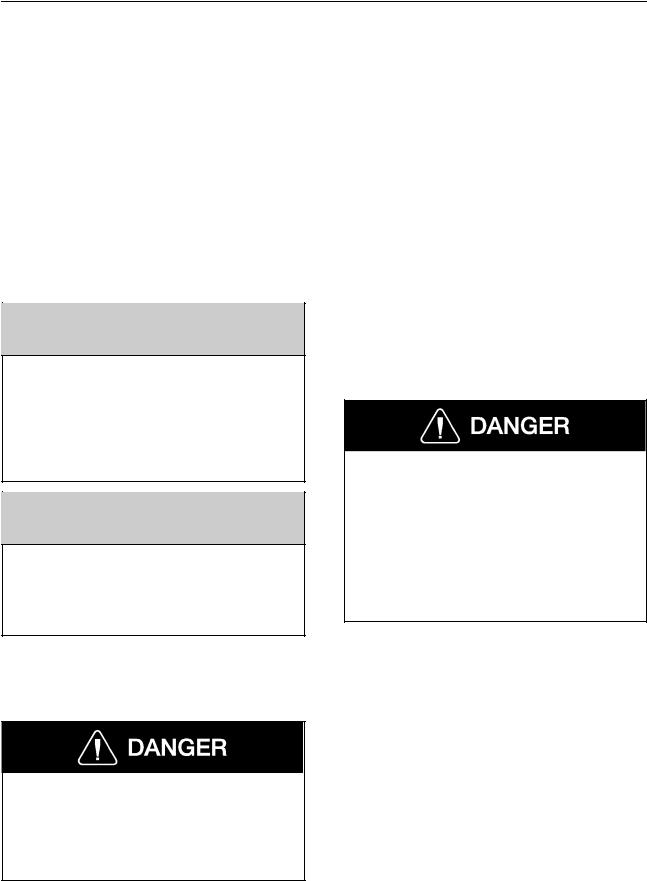
Safety Information 3
Proper Maintenance Procedure
During Maintenance
Whenever performing maintenance or repair, attach a DO NOT OPERATE or similar warning label or sign to the ignition key or prominently displayed on the instrument panel.
Do not allow unauthorized personnel on, around or in the vehicle when maintenance or repair is being performed.
 WARNING
WARNING
Do not attempt to repair or service this vehicle without having sufficient training, correct service literature and the proper tools. Failure to follow this could lead to personal injury or making your vehicle unsafe.
 WARNING
WARNING
Diesel engine exhaust and some of its constituents are known to the state of California to cause cancer, birth defects and other reproductive harm.
•When operating the engine in an enclosed area, vent the exhaust to the outside.
Exhaust gases contain carbon monoxide. Always run the engine outdoors or use a properly vented exhaust hose. Prolonged or excessive exposure may cause serious illness or death.
•Before servicing your vehicle, apply the parking brakes and adequately chock the wheels in order to prevent unintended vehicle movement. If the service procedure requires the parking brakes to be released — recheck to ensure that the wheels are adequately chocked to prevent all forward and/or rearward movement.
•Do not use combustible substances in or around the engine either during repair or maintenance or when running the engine.
Never operate the engine in an area where hydrocarbon vapors (gasoline, for example) are present or are suspected to be present. Hydrocarbon vapors can enter the air intake and overspeed the engine, causing severe engine damage and/or an explosion and fire. Serious personal injury or death could occur.
•Do not wear loose clothing or jewelry that can catch or get snagged by parts or moving components on the engine. Also wear all protective equipment required by the job conditions, such as protective glasses, hearing protection, etc.
•Make certain that all protective covers and guards are in place and secured.
•Never put maintenance fluids into glass containers since glass containers can break.
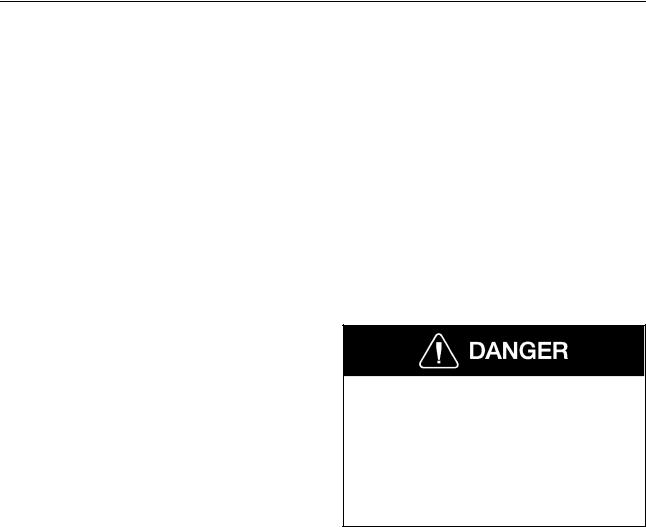
4 Safety Information
•Report all problems in a timely manner before they threaten the safety of operating the vehicle.
•Do not work on the engine while it is running.
•Tag the vehicle with the DO NOT OPERATE sign. Make sure other protective locks and covers are in their proper place.
•Disconnect the batteries whenever performing any repairs or before servicing the electrical system.
•DO NOT use high amperage electronic starting devices for jump-starting the engine. Rely on conventional battery charging for charging the batteries or jump-start with the help of a start battery.
•DO NOT attempt repairs you do not understand or have the proper tools for.
•When starting an engine after repairs have been made to the fuel or injection system, prepare equipment for shutting off the engine intake air and/or fuel supply (to stop the engine), in case there is an overspeed on start-up.
•Start the engine only from the driver seat. Never operate the starter motor across the starter terminals or the batteries as this could by-pass the engine neutral-start system as well as causing damage to the electrical or electronic systems.
Never try to operate or work on this vehicle while under the influence of alcohol. Your reflexes can be affected by even a small amount of alcohol. Drinking and operating this vehicle can lead to an accident, causing serious personal injury or death.
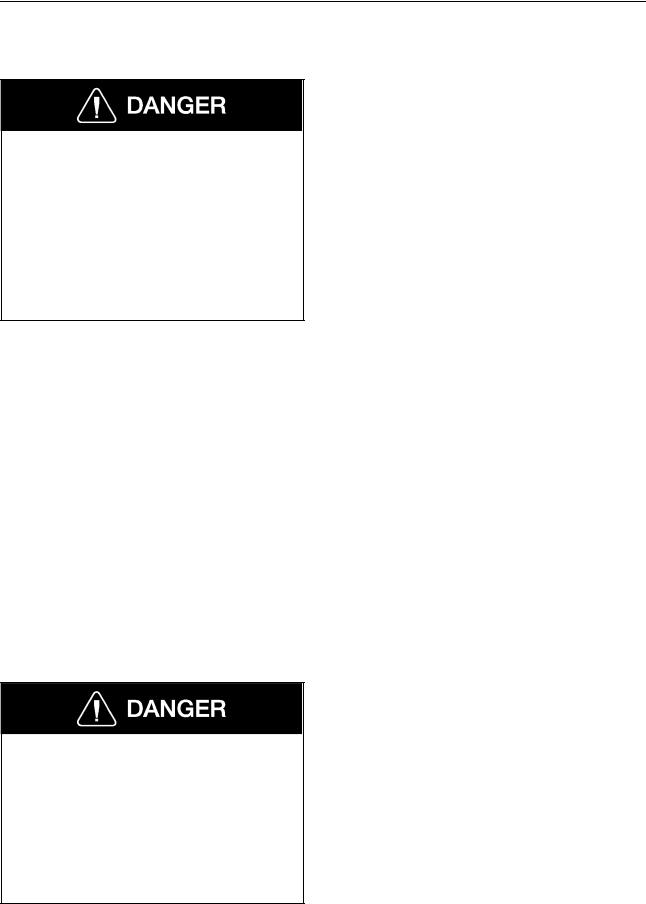
Safety Information 5
Compressed Air and Water
Compressed air can cause personal injury. When using compressed air for cleaning, wear a protective face shield, protective clothing and protective shoes. Pressurized water could cause particles and/or hot water to be sprayed in your direction and cause personal injury. The maximum air pressure must be below 30 psi (200 kPa) for cleaning purposes.
Asbestos Information
NOTE! The Volvo engine and replacement parts for it shipped from the factory are asbestos free. Volvo recommends the use of only genuine Volvo spare parts.
Never use any parts that contain or are thought to contain asbestos. Exposure to asbestos fibers can create serious health risks, including death.
Fluid Penetration
Always use a piece of paper or cardboard when checking for a leak. Escaping fluid under high pressure, even a pin-hole sized leak, can penetrate body tissue, causing serious injury or death. If fluid is injected into your skin, immediate treatment must be administered by a doctor familiar with this type of injury.
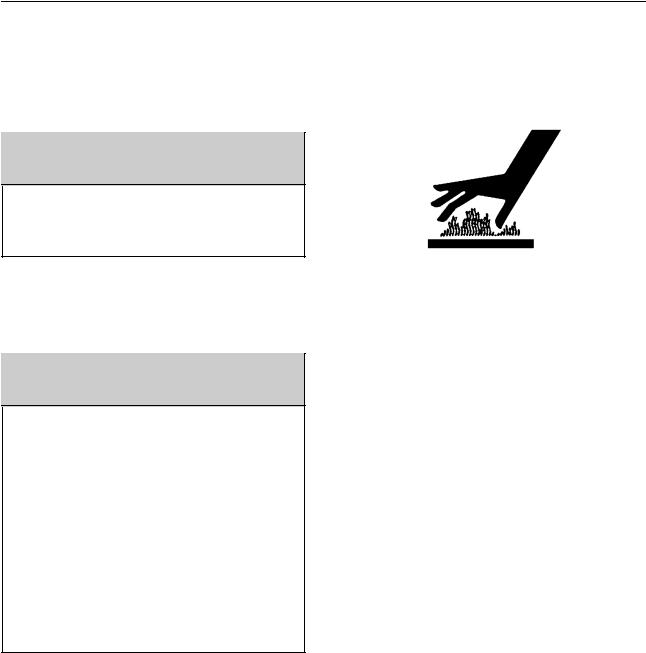
6 Safety Information
Injury Prevention
Burn Prevention
Engine Parts
 WARNING
WARNING
Hot engine. Keep yourself clear of all hot engine parts and/or fluids. A hot engine and/or fluid can cause serious burns.
W0001525
Do not touch any part of the engine while it is hot. Allow the engine to cool before any repair or maintenance is performed on the engine.
 WARNING
WARNING
Do not raise the engine hood or cab if you see or hear steam or coolant escaping from the engine compartment. Wait until steam or coolant cannot be seen or heard any longer before raising the hood or cab.
Do not remove the coolant fill cap if the coolant in the surge tank is boiling. Also, do not remove the cap while the engine and radiator are still hot. Scalding fluid and steam may be blown out under pressure if the cap is taken off too soon.
Relieve all pressure in air, oil, fuel or cooling systems before any lines, fittings or related items are disconnected or removed.

|
Safety Information |
7 |
Coolant |
|
|
To prevent personal injury, do not climb up |
|
|
on the engine to remove the filler cap. Use |
|
|
a suitable, properly positioned ladder to |
|
|
reach up to the cap. At normal operating |
|
|
temperature, the engine coolant is very hot |
|
|
and under pressure. If pressure is relieved |
|
|
rapidly in a hot cooling system, the hot |
|
|
coolant can turn into steam. Any contact |
|
|
with hot coolant or steam can cause severe |
|
|
burns. The radiator and all heating system |
|
|
and radiator lines and hoses contain hot |
|
|
coolant. |
|
|
|
|
|
WARNING |
|
|
|
|
|
Coolant may be combustible. Coolant |
|
|
leaked or spilled onto hot surfaces or |
|
|
electrical components can cause a fire. |
|
|
Clean up coolant spills immediately. |
W0001527 |
|
|
|
|
|
|
|
Verify coolant level only by the markings |
|
|
on the expansion tank. Open the filler cap |
|
|
only after the engine has been stopped and |
|
|
cooled down. Remove the filler cap slowly |
|
|
to relieve pressure. |
|
|

8 Safety Information
Oils
 WARNING
WARNING
Hot engine. Keep yourself clear of all hot engine parts and/or fluids. A hot engine and/or fluid can cause serious burns.
Hot oil can cause severe burns. Do not allow hot oil to contact the skin. When changing oil, wear protective gloves.
Batteries
WARNING
Always wear eye protection when working around batteries to prevent the risk of injury due to contact with sulfuric acid or an explosion.
 WARNING
WARNING
Battery posts, terminals and related accessories contain lead and lead compounds, chemicals known to the State of California to cause cancer and reproductive harm. Wash hands after handling.
Battery electrolyte contains acid and can cause injury. Avoid contact with the skin and eyes. Wash hands after touching batteries and connectors. Use of gloves is recommended. Always wear protective glasses when working with batteries.
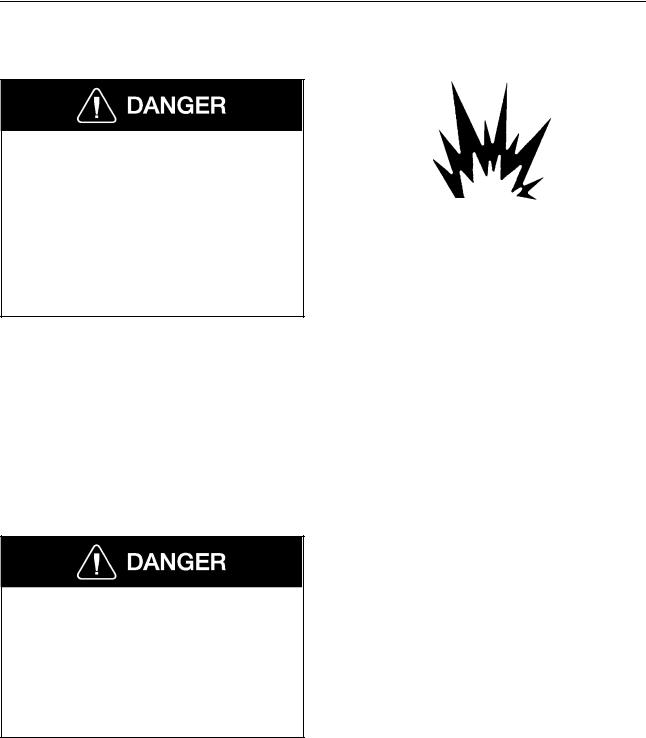
Safety Information 9
Fire or Explosion Prevention
The diesel engine will operate on any fuel which enters the cylinder, whether it is from the injectors or from the air in-
take system. Therefore, if any solvent is
W0001526
used to flush out the air cleaner element, the engine may overspeed during start-up. Engine damage and severe injury and/or death from burns or explosion can occur.
The engine should not be operated in an area where combustible gases are suspected to be in the air. These could be drawn into the engine through the engine air intake system and could cause the engine to overspeed with possible serious damage to the engine and bodily injury or property damage.
Excessive heat may cause the pressurized components of the air conditioned system to explode. Never weld, solder, steam clean or use a gas torch near any part of the air conditioning system. Severe injury or death may occur from an explosion.
Do not pressure or leak test R134a refrigerant for air conditioning or servicing equipment using compressed air. Some mixtures of air and R134a refrigerant have been shown to be combustible at elevated pressures. These mixtures, if ignited, can cause injury or property damage. Consult the R134a Material Safety Data Sheet (MSDS) for additional information.
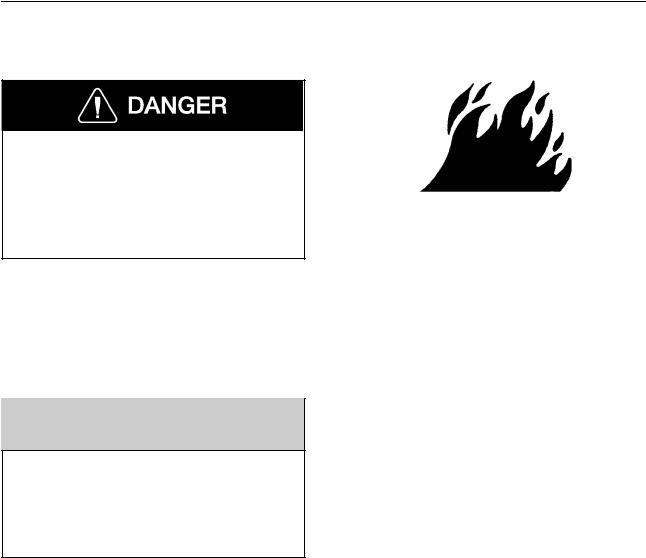
10 Safety Information
Do not service any part of the fuel system while smoking or in the presence of flames, sparks or hot surfaces. Failure to
follow these precautions can result in W0001527 fire, which can cause serious injury or
death.
All fuels, most lubricants and some coolant mixtures are flammable. Diesel fuel is flammable. Gasoline is flammable. The mixture of diesel and gasoline fumes is extremely explosive. Do not smoke while refueling or when in a refueling area.
 WARNING
WARNING
Do not store fuel containers in the vehicle. They may leak, explode and cause or feed a fire. Empty or full, they present a hazard that may lead to burns in the event of a fire.
Keep all fuels and lubricants stored in properly marked containers and away from all unauthorized personnel. Store oily rags or other flammable material in a protective container, in a safe place. Remove all flammable material such as fuel, oil and other substances before they accumulate on the engine. Do not expose the engine to flames, driving over burning ground, etc., if at all possible. Do not weld or flame cut on or around pipes or tubes that contain flammable fluids.
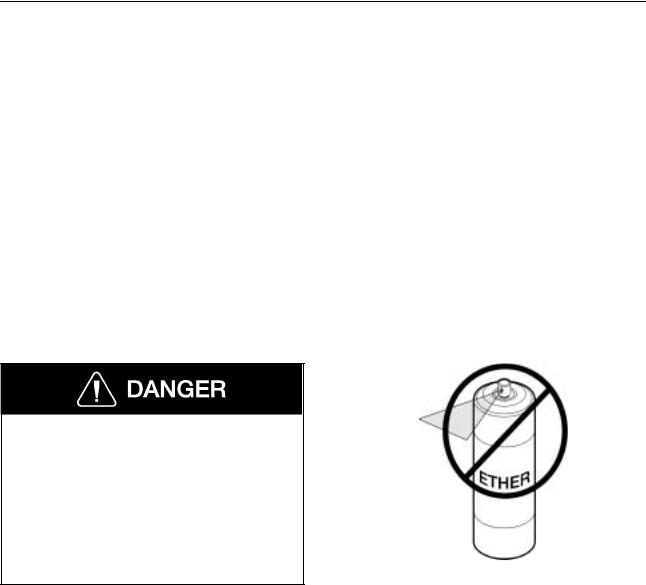
Safety Information 11
Exhaust heat shields may be installed to protect oil or fuel carrying lines and pipes from hot exhaust parts. To protect from pipe or seal failure, install heat shields correctly.
Provide adequate and proper waste oil disposal. Always dispose of waste liquids according to Federal and local regulations. Oil and fuel filters should be properly installed and housing covers tightened to the proper torque when being changed.
Starting Aids
Do not use ether or similar starting aids in a Volvo or any other engine with start help. The Volvo engine is equipped with a preheater. Introduction of ether or other combustible material in the intake manifold could cause a fire or explosion, resulting in severe property damage, se-
vere personal injury or death.
W0001484
DO NOT use ether or other combustible starting aids on engines that have a heater element or other heating devices installed in the intake manifold for heating intake air at cold-starts.
Fire Extinguisher
Anytime work is being done to the fuel system or any other area where flammable substances are being used, have a fire extinguisher available and know how to use it. Inspect and have it serviced as recommended on its instruction label.
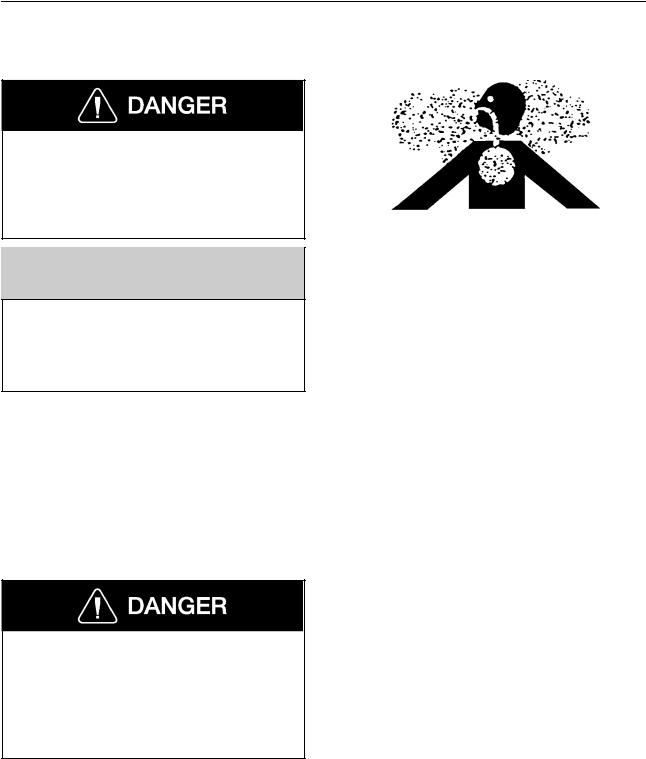
12 Safety Information
Respiratory Hazard Prevention
Exhaust gases contain carbon monoxide. |
|
Always run the engine outdoors or use a |
|
properly vented exhaust hose. Prolonged |
|
or excessive exposure may cause serious |
|
illness or death. |
W0001523 |
 WARNING
WARNING
Diesel engine exhaust and some of its constituents are known to the state of California to cause cancer, birth defects and other reproductive harm.
Always work in a well ventilated space if the engine needs to be running and use a hose to route the exhaust to the outside.
Poisonous Substances
Coolant is toxic; risk of poisoning. Do not drink coolant. Use proper hand protection when handling. Keep coolant out of reach of children and animals. Failure to follow these precautions can cause serious illness or death.
Cooling system supplemental additive contains alkali. To prevent personal injury, avoid contact with the skin and eyes. DO NOT drink coolant of any concentration.
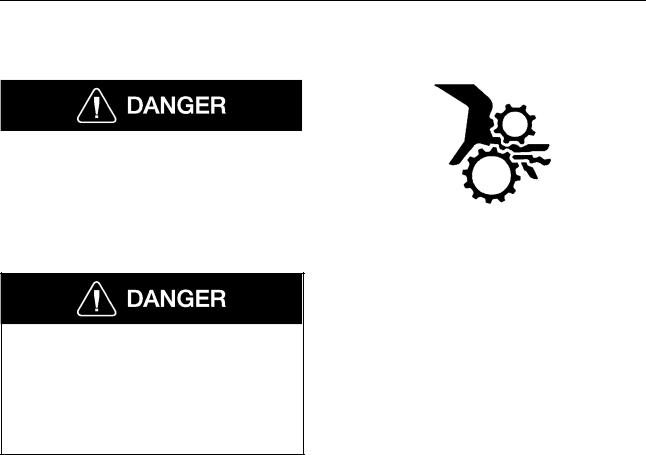
Safety Information 13
Crushing or Cutting Prevention
Before working on a vehicle, set the |
|
|
parking brakes, place the transmission in |
|
|
neutral and block the wheels. Failure to |
|
|
do so can result in unexpected vehicle |
W0001524 |
|
movement and can cause serious per- |
||
|
||
sonal injury or death. |
|
|
|
|
Do not work near the fan with the engine running or the ignition in the ON position. The engine fan can engage at any time without warning. Anyone near the fan when it turns on could be seriously injured.
Support equipment and components properly when working beneath them. Never attempt adjustments while the engine is running unless otherwise specified for the service procedure. To help prevent an accident caused by moving parts, work carefully around them. Guards, covers and shields should be in place whenever maintenance is not being performed. Keep objects away from moving fan blades. They will throw or cut any object or tool that falls or is pushed into them.
Inspect the fan blade assembly before service for cracks or loose mounting before starting the engine. Never stand along side a rotating fan assembly, particularly at high fan speeds.
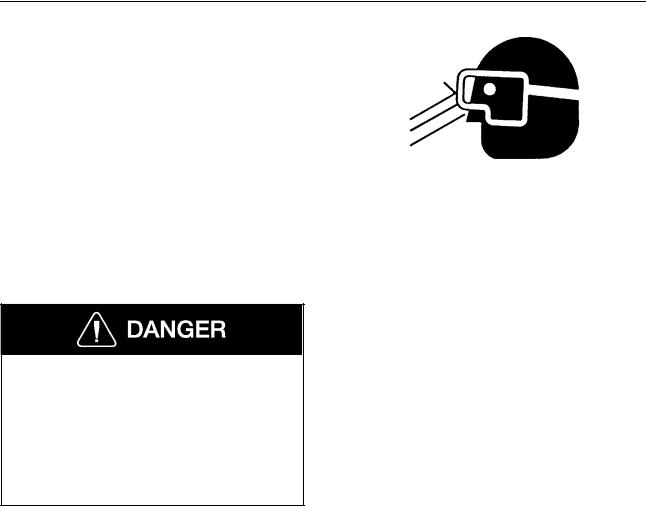
14 Safety Information
Wear protective glasses when striking objects to avoid injury to your eyes. Chips or other debris can fly off objects that are struck. Make sure no one can be injured by flying debris before striking any object.
W0001528
Climbing Up and Down
Always have three limbs (one foot and two hands or two feet and one hand) in contact with the vehicle at all times when entering or exiting the cab or the area behind the cab. Failure to follow this warning can result in serious personal injury or death.
DO NOT climb up on or jump off from the engine or stand on components that cannot support your weight. Use an adequate ladder or scaffolding, suitably situated. Do not use top of engine or cowling ledge as foothold when reaching on top of cab. Clean steps, handholds and areas of the vehicle you will be working on or around. Refer to the Operator’s Manual for proper entry and exit procedures.
Always use a three-point stance (two hands — one foot or one hand — two feet) whenever climbing up or down.
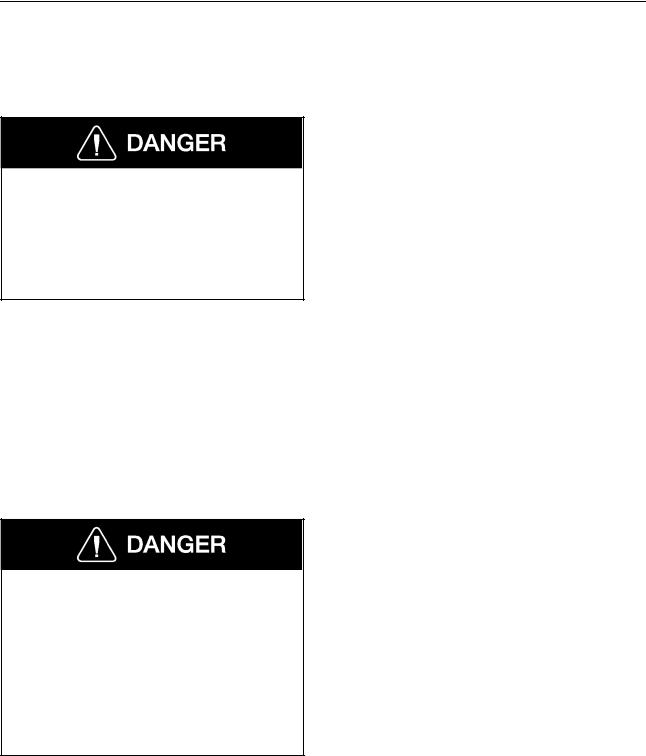
Safety Information 15
Engine Damage Prevention
Before Starting the Engine
Before working on a vehicle, set the parking brakes, place the transmission in neutral and block the wheels. Failure to do so can result in unexpected vehicle movement and can cause serious personal injury or death.
Inspect engine for potential hazards. Make sure all protective guards and covers are properly installed if an engine needs to be started to make adjustments or checks. To help prevent an accident by moving parts, work carefully around them.
DO NOT disable or bypass automatic alarm/shutoff circuits. They are provided to prevent personal injury and engine damage.
The diesel engine will operate on any fuel which enters the cylinder, whether it is from the injectors or from the air intake system. Therefore, if any solvent is used to flush out the air cleaner element, the engine may overspeed during start-up. Engine damage and severe injury and/or death from burns or explosion can occur.
Make provisions for shutting off the engine intake air or fuel supply to stop the engine if there is an overspeed on start-up after performing repair or maintenance on it.
Always consult the proper Volvo Service
Manual before any repair is attempted.
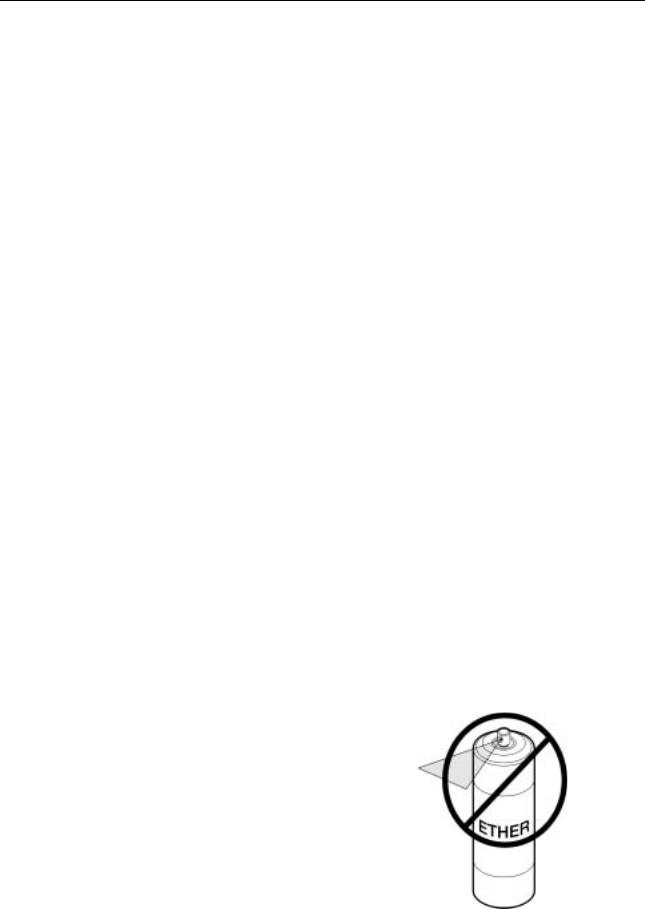
16 Safety Information
Engine Starting
DO NOT start the engine or move any of the controls or disengage the parking brake if the warning tag “DO NOT OPERATE” is attached to the ignition key or located on the dash. Check with the person who attached the tag before starting.
Make sure no one is working on or close to the engine or components driven by the engine before starting it. Always make an inspection of the engine before and after starting.
Diesel engine exhaust contains products of combustion which may be harmful to your health. Always start and operate the engine in a well-ventilated area, and if in an enclosed area, vent the exhaust to the outside.
Start the engine only from the driver seat in the cab. Never start the engine by shorting across the starter motor terminals or batteries to start the engine as this could bypass the engine neutral-start system as well as damage the electrical and electronic system. Always start the engine according to the required engine starting procedure described in this operator’s manual to prevent major engine component damage and personal injury.
Starting Aids
DO NOT use ether or other combustible starting aids on engines that have a heater element or other heating devices installed in the intake manifold for heating intake air at cold-starts. Introduction of ether or similar starting aids could cause a fire or explosion resulting in severe property damage, serious personal injury or death.
W0001484
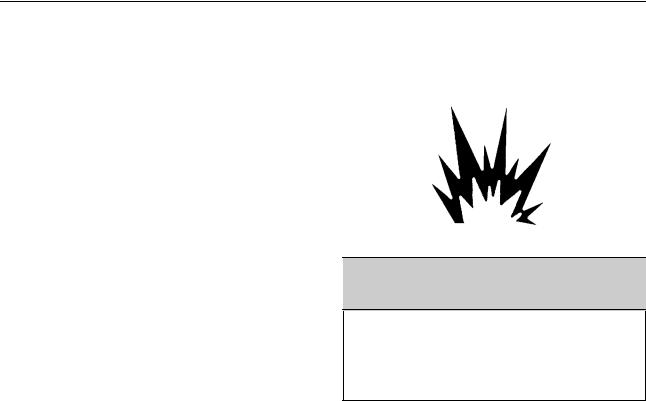
Safety Information 17
Electric System Damage Prevention
Electric and Electronic Systems
Never disconnect any charging unit circuit or battery circuit cable from the battery when the charging unit is operating. A spark can cause the flammable vapor mixture of hydrogen and oxygen to explode.
To prevent potential sparks from igniting combustible gases produced by some batteries, attach the negative (-) terminal last when hooking up and remove the negative terminal first after the engine has started.
Check regularly around the engine and engine compartment for loose or frayed wires. Have all loose or frayed electrical wires tightened, repaired or replaced before operating the vehicle.
W0001526
 WARNING
WARNING
Always wear eye protection when working around batteries to prevent the risk of injury due to contact with sulfuric acid or an explosion.
Grounding Practices
Proper grounding for vehicle and engine electrical and electronic systems is necessary for proper vehicle and engine performance and reliability. Improper grounding will result in uncontrolled and unreliable electrical paths.
Uncontrolled engine electrical circuit paths can result in damage to main bearings, crankshaft journals surfaces and aluminum components. Uncontrolled electrical circuit paths can also cause electrical noise which may degrade vehicle and radio performance.
Operating engines without the engine-to- frame ground strap installed can cause damage to the engine. To prevent electrical discharge damage, check to make sure the engine’s electrical system has an engine-to- frame ground strap. All ground connections should be tight and free of corrosion.

18 Safety Information
Electronic Engine Control System
Tampering with the electronic system installation can be dangerous and could result in personal injury or death and/or engine damage. It is very important to take the proper precautions with the electrical and electronic system when charging the batteries, jump-starting or performing electric welding on the vehicle. See the vehicle Operator’s Manual for correct procedures.
The Volvo D12 engine uses high voltage |
|
|
to the electronic unit injectors. DO NOT |
|
|
come in contact with the unit injector |
|
|
terminals while the engine is running. |
W0001522 |
|
An electric shock can cause an involun- |
||
|
||
tary muscle spasm and cause balance |
|
|
loss and falls leading to severe personal |
|
|
injury or death. |
|
|
|
|
|
This engine is equipped with monitoring |
|
|
features that may cause reduced power or |
|
|
shutdown under certain conditions. The |
|
|
power output, monitoring and idling fea- |
|
|
tures can only be programmed and/or |
|
|
changed with electronic service tools and |
|
|
passwords. |
|
Certain features, such as low oil pressure, high coolant temperature or low coolant level could cause the engine power and/or vehicle speed to be limited and the engine may also shut down. The shutdown will take approximately 30 seconds from the time the warning feature is activated. See the vehicle Operator’s Manual for more information.

Safety Information 19
Reporting Safety Defects
USA
The National Highway Traffic Safety Ad-
ministration (NHTSA) and Volvo Trucks North America should be informed imme-
diately if you believe that the vehicle has a defect that could cause a crash, injury or death.
Contact NHTSA by calling the Auto Safety Hotline at 1 (800) 424–9393 (or 366–0123 in the Washington, DC area) or by writing to: NHTSA, U. S. Department of Transport, Washington, DC 20590.
Canada
Refer consumer complaints to Volvo Trucks Canada, Inc. or to the Transport Canada — Department of Public Complaints, Recalls and Investigations.
Mexico
Volvo Trucks of Mexico, S.A. de C.V. should be informed immediately if you believe the vehicle has a defect that could cause a crash, injury or death. Contact Volvo Trucks de Mexico by calling 91 (5) 259–3011 or by writing to: Volvo Trucks de Mexico, S.A. de C.V., Prol. Paseo de la Reforma 600, 1er. Piso — 121, Col. Santa Fe Peña Blanca, C.P. 01210, México, D.F.
1 (800) 424-9393
1 (905) 795-1555
01 (800) 90 94 900
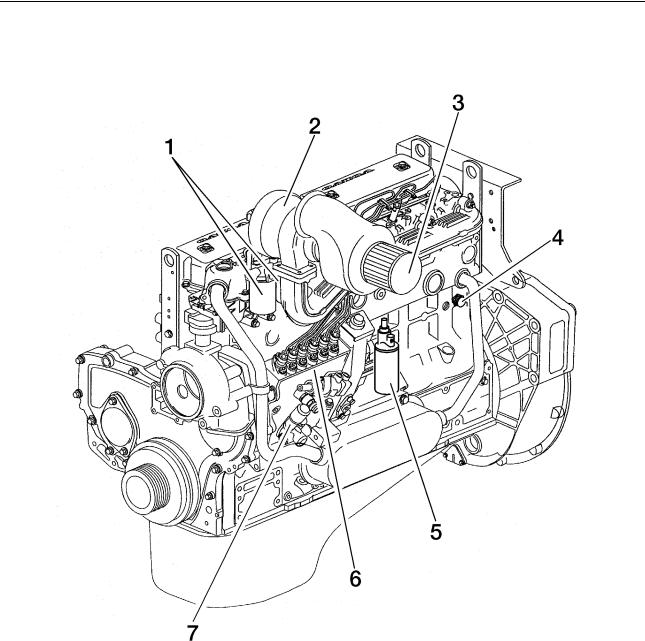
20 General Engine Design Information
Engine Overview D7
|
|
|
W2002703 |
1. |
Fuel filters (secondary) |
5. |
Coolant filter |
2. |
Turbocharger |
6. |
Electronic injection pump |
3. |
Exhaust pressure governor (EPG) |
7. |
Hand fuel primer pump |
|
|
4.Coolant drain connection
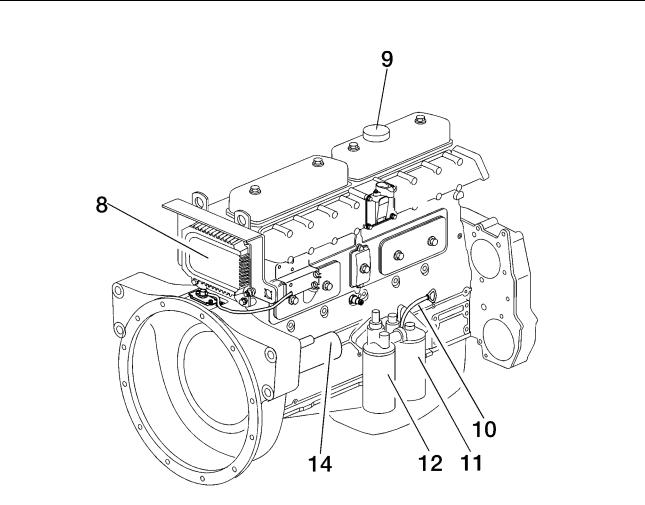
General Engine Design Information 21
|
|
|
W2002702 |
8. |
Engine electronic control unit |
11. |
By-pass oil filter |
|
(EECU) |
12. |
Full-flow oil filter |
9. |
|
||
Oil fill cap |
14. |
Starter motor |
|
|
|
||
10. |
Oil dipstick |
|
|

22 General Engine Design Information
Engine Overview, D12
|
|
|
W0001846 |
1. |
Oil Fill Cap |
4. |
Fuel Filter (secondary) |
2. |
Starter Motor |
5. |
Oil Dipstick |
3.Engine Electronic Control Unit (EECU)
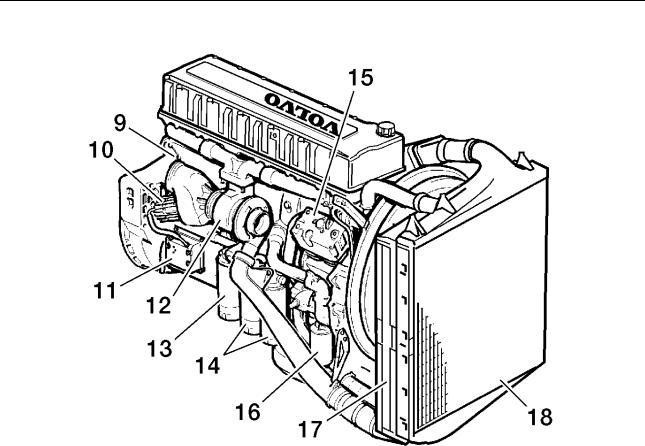
General Engine Design Information 23
|
|
|
W0001847 |
9. |
Coolant Drain Connection |
14. |
Full-Flow Oil Filters |
10. |
Exhaust Pressure Governor |
15. |
Air Compressor |
|
(EPG) |
16. |
Coolant Filter |
11. |
|
||
VEB Control Unit |
17. |
Coolant Radiator |
|
|
|
||
12. |
Turbocharger |
18. |
Charge Air Cooler |
|
|
||
13. |
By-Pass Oil Filter |
|
|
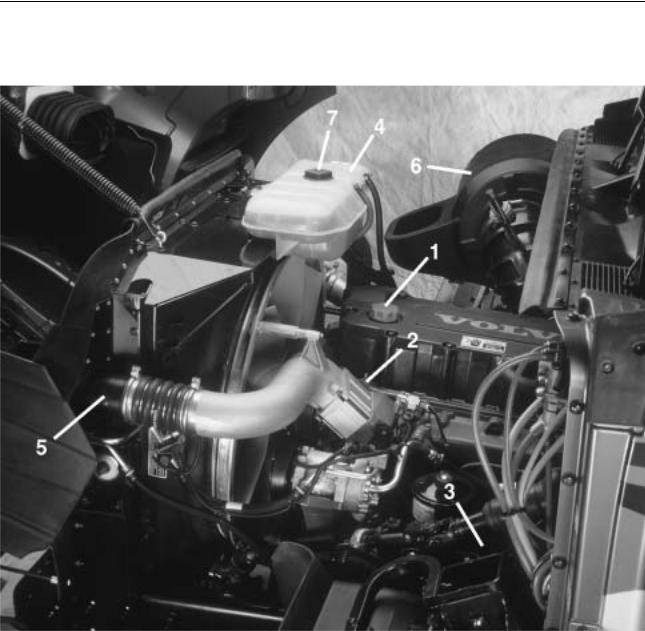
24 General Engine Design Information
Typical Engine Compartment Overview
1.Oil fill cap
2.Intake air heater
3.Engine Electronic Control Unit (EECU)
W2003478
4.Coolant surge tank
5.Output from charge air cooler
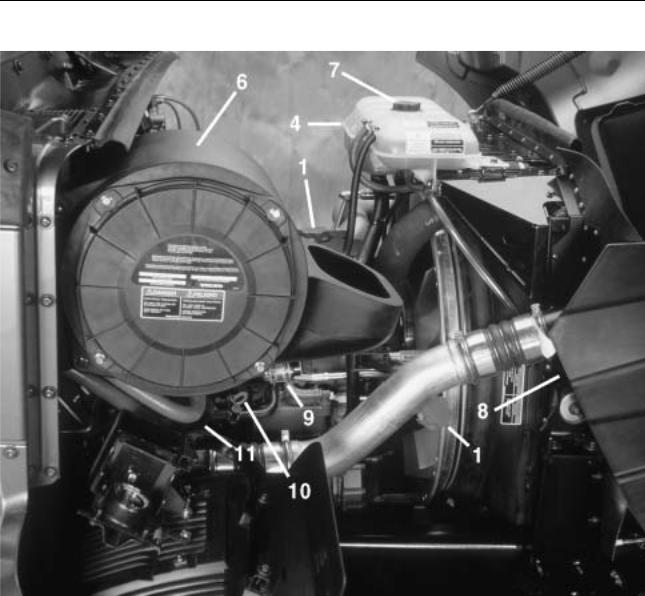
General Engine Design Information 25
W2003479
6. |
Engine air filter |
9. |
Airfilter restriction gauge |
7. |
Coolant fill cap |
10. |
Oil dipstick |
|
|
||
|
|
11. |
Turbocharger |
8.Radiator

26 General Engine Design Information
Engine Features
|
Feature |
|
• |
VECTRO II - Volvo Engine |
• |
|
Electronics System |
• |
|
|
• |
|
|
• |
|
|
• |
|
|
• |
|
|
• |
• |
VECTRO II Diagnostics |
• |
• |
Air-to-Air Charge Air Cooler |
• |
|
|
• |
|
|
• |
Benefit
Engine Brake Control (D12)
Differentiated Speed Control
Road Speed Limiter
PTO Speed Setting
Cruise Control
Idle Speed Setting
Idle Timeout
Ease of Troubleshooting
Superior Fuel Economy
Peak Performance
Low Process Temperature
• Two-Piece Piston and Optimized |
• |
Minimum White Smoke |
Compression Ratio (D12) |
• |
Low Internal Friction |
• Standard Exhaust Brake |
• |
|
• |
|
• |
Efficient Braking on Grades Superior Temperature Control at Idle Quick Warm-Up
• |
Optional Volvo Engine Brake (VEB) |
• |
Exceptional Engine Braking Even at |
|
(D12 only) |
|
Low Engine Speed |
|
|
|
|
• |
Optional Pre-Heater Element |
• |
Excellent Startability down to as Low |
|
|
|
as |
|
|
• |
-15 F (-25 C) |
|
|
Minimum Smoke and Odor After Start |
|
|
|
• |
No Fuel Dilution of Oil in Cylinder |
|
|
• |
Due to Complete Combustion |
|
|
Less Engine Wear |
•
•
Cylinder Liners with Plateau Honing |
• |
Optimized Oil Consumption |
Engine-Mounted Fan Ring |
• |
Efficient Cooling with Low Parasitic |
|
|
Losses |
• Electronically Controlled Fuel Injection • |
Precise Control of Combustion |
• |
Centrally Located Vertical Unit |
• |
Injectors |
Maximum Fuel Efficiency |
• Engine-Driven Power Take-Off |
• Clutch-Independent PTO |
